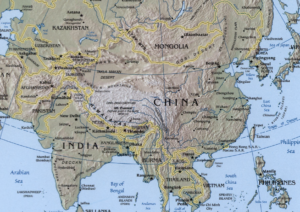Recently released measurements by the U.S. National Oceanic and Atmospheric Administration (NOAA) of carbon dioxide (CO2) levels in the atmosphere show that concentrations of this heat-trapping gas have risen to record levels not seen by scientists since the era of modern readings.
According to NOAA, May recorded the highest CO2 levels so far in 2021, with the average concentration at 419.13 parts per million (ppm).
“We are adding about 40 billion metric tons of CO2 pollution to the atmosphere per year,” said senior climate scientist Pieter Tans of NOAA’s Global Monitoring Laboratory.

“If we want to avoid catastrophic climate change, the highest priority must be to reduce CO2 pollution to zero as quickly as possible.”
The new peak of 419.13 ppm, scientists say, is the highest monthly average since accurate atmospheric measurements began about 60 years ago. It was measured at NOAA’s Mauna Loa Atmospheric Baseline Observatory in Hawaii.
But the true scale of this result cannot be measured in decades, since you would have to go back much, much further back in time to find Earth’s atmosphere as overloaded with CO2 as it is now.
How far back? Well, around the Pliocene period, specifically about 4.1 to 4.5 million years ago, says NOAA, which was the last time the atmospheric carbon dioxide load was comparable to today’s polluted skies.
We know this because researchers have reconstructed previous atmospheric CO2 concentrations using complex approximation methods, such as carbon isotope compositions found in marine sediments from various oceanic spots around the world and by surveying ancient and extremely deep ice sheets in the Arctic.
The high levels of atmospheric CO2 accumulated during the late Pliocene period meant that the world was a very different place then, about 2 to 3 degrees Celsius warmer compared to the baseline of the pre-industrial period.
In that period, the Earth’s polar regions were so warm that they had forests, and the ice that would later form in Antarctica and the Arctic was still liquid water – raising the oceans to a sea level 20 meters higher than it is today.
Scientists fear that we may be only hundreds of years away from a return of these conditions once the CO2 levels we have now have enough time to warm the planet again.
Even before we get there, the projected rise in sea level by the end of this century could threaten the displacement of hundreds of millions of people – and for many who find safety on dry land, the deadly heat will be unbearable, as already seen in parts of India during the summer.
But how can we be sure that NOAA’s measurements are correct?
Other scientists are seeing the same thing.
Separate measurements conducted by the Scripps Institution of Oceanography largely confirm NOAA’s own numbers, albeit with a very small difference – with the Scripps team averaging 418.92 ppm for May (up from 417 ppm a year earlier).
On at least some days in 2021, in fact, the Scripps researchers observed daily levels exceeding 420 ppm, setting another disastrous record in human history.
In any case, the new results belong in a familiar and firmly established context. They are just the latest evidence of an unchanged trajectory of CO2 levels, a story we find ourselves telling year after year, over and over again.
What is clear is that despite the pandemic shutdowns – and the temporary drops in pollution they provided – this kind of emissions reduction was not enough for us to still see a significant effect on overall atmospheric CO2 concentrations, especially against the backdrop of natural carbon emission fluctuations.
Perhaps a 30% drop in human emissions, lasting at least six months, might show an observable effect, scientists think. But we failed to reduce that 30% even during the pandemic, during which emissions fell only about 6%.
And all the other signs say we’re running in the wrong direction anyway.
“The last decade has seen the fastest [CO2] growth of any decade in human history,” Scripps geochemist Ralph Keeling told The New York Times.
“So it’s not just that the levels are high, it’s that they’re still rising rapidly.”
Why is global warming an extremely important phenomenon in geopolitical terms and for humanity in general?
Some of the consequences of global warming are obvious such as:
- increase in temperature in general
- this increase will lead to further melting of the ice at the poles, raising sea levels and possibly flooding coastal cities like Rio de Janeiro, Miami, among others
- increase in temperature in some parts of the planet where it will be impossible for humans to live and thrive
Other secondary consequences of global warming can lead to regional conflicts:
- this extreme temperature rise will lead to mass migrations of people, which may cause social conflicts and uprisings in the region of departure and destination
- as the Arctic melts, new shipping routes and shipping areas will open up in the region
- as part of the Arctic region is disputed between countries like Russia, the United States, Denmark, Norway, and Canada, the potential for conflict may increase
- by the way, there is already increased militarization of the Arctic with the United States flying strategic bombers over the region and Russia reopening several military bases on its Arctic coast
- China is also more present in the region, including the Arctic in its global development project BRI (Belt and Road Project) to reactivate the “silk route” between it (goods producing region) and the rest of the world (consuming region) with infrastructure projects to facilitate global connectivity and increase Chinese geopolitical influence
What are the possible solutions to the global warming/climate change problem
There are many possible solutions, but some are not yet technically possible, others are not politically possible:
- considerable elimination of the use of fossil fuels for transportation and energy (oil, gas, and coal)
- renewal of the internal combustion car fleet with electric cars
- increased production of energy from renewable sources (wind, solar, geothermal, hydroelectric, etc.)
- increased use of chemical and hydraulic batteries for storing renewable energy
- possible increase in the use of nuclear energy (nuclear fission) as a transitional form of energy between fossil fuels and fully renewable energy (there is still much debate and controversy about the use of nuclear energy)
- use of nuclear fusion – clean and almost unlimited energy. However, the technology is not yet fully developed. The multinational experimental nuclear fusion reactor in France, ITER, holds great promise in this area
- increased use of hydrogen for storing energy and in mass transport such as ships and airplanes
- overall reduction in the use of single-use plastics
- increased planting of trees
- decreased deforestation in general
- among many other possible actions on a regional, national, and global level














[…] formed working groups on COVID-19 vaccines, climate change, technological innovation, and resilience of global supply […]